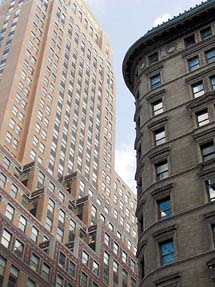SECURITY Services: Escaping High-rises in Emergencies

Some devices are fairly inexpensive, work well for the purpose for which they were designed and have a proven record of success in the field under actual conditions. Regard these as essential items. Other devices may be cost prohibitive for the average building tenant. Furthermore, some may not have a proven record of success under actual field conditions by untrained personnel. It is therefore best to weigh the likely threats and facility vulnerabilities against the costs of mitigation.
Fire Blankets
Each year, some 4,500 people die as a result of fires, and another 30,000 are seriously injured in the United Sates alone. An inexpensive and readily available solution to provide temporary protection to personnel exiting a burning building is a fire blanket. These blankets are typically double woven silica fiber that will not burn or melt. Many fire blankets are safe for between 1,400 and 1,800 degrees Fahrenheit, with some rated up to 3,000 degrees Fahrenheit for short-term exposure.The blankets have another use for smothering or containing small fires. These fire blankets come in a rather compact size, with some wall-mountable in an aluminum storage container. A person just pulls on a set of tabs to open. Fire blankets can also be reused after a fire. One can simply wash it, roll it up and then reinsert the blanket into the storage canister.
Other units come with a smoke hood and integral HEPA filter.

Escape Masks
Emergency escape masks provide temporary protection from smoke, chemical and biological hazards. They come in a wide range of designs and prices. Some masks provide emergency respiratory and eye protection from chemical and biological terror threats including hydrogen cyanide, sarin, phosgene, ammonia, sulfur dioxide, chlorine, tear gas, smoke, radioactive and highly toxic particles, anthrax, smallpox, as well as other airborne viruses and bacteria. However, most of these units do not protect against carbon monoxide, a common by-product of combustion. Some filter designs have an external polyester screen, an electrostatic particle filter and two layers of activated charcoal cloth with special impregnation. Other designs utilize activated military-grade carbon filters.Typically, emergency masks are shipped in protective foil bags to keep them at peak effectiveness until opened for use. Most in this class weigh less than 11 ounces in the unopened package and are approximately 7 inches x 5 inches x 2.5 inches in size, making them very compact and easy to store or carry. Speech and hearing are not impaired while wearing the mask.
Other units provide additional protection from carbon monoxide gas. This is the most hazardous and most likely agent to be encountered from combustion during a building fire. While they have a greater range of protection than other less costly filters, they are less compact in size and cannot be carried as easily in a small pocketbook.
Some emergency escape respirators contain a five-minute supply of compressed air from a self-contained cylinder. Available from a number of lab supply outfits as well as on the Internet, these units tend to be quite expensive, making them somewhat cost prohibitive.
An emergency escape smoke hood commonly seen in magazines, catalogs and on the Internet is the EVAC-U8. This unit is inexpensive. Many people have purchased this unit with the expectation that it would provide suitable emergency protection from tear gas or chemical warfare agents. However, in July of 2002, in cooperation with the Consumer Products Safety Commission, the manufacturer voluntarily recalled these units. This smoke hood is rated by the manufacturer to only provide temporary protection from smoke in the event of a fire, and will not provide protection from other hazards. The EVAC-U8 also will not provide protection from carbon monoxide gas.
A recent arrival is a gas mask that contains an integral blower to maintain a positive pressure inside the hood. This positive pressure affords an additional level of protection for the wearer against chemical warfare agents. However, the unit does not provide protection from carbon monoxide gas and is not designed to be a smoke hood. The system includes a battery that automatically activates the blower when the unit is removed from the factory packaging. The blower is constructed of strong impact-resistant polycarbonate and is rated for four hours of continuous use. The product is from ILC Dover, Frederica, Del., the designer and producer of NASA’s space suits and producer of the M40 US military gas mask.

Emergency Escape Parachutes
When there are no other means of escape from a high-rise office building, emergency escape parachutes are available, and represent the latest in escape devices. They are available from a variety of manufacturers. It is important to note here that emergency escape parachutes have no proven track record as emergency building egress devices and have never been used by untrained personnel under actual crisis conditions. To date, they have only been tested and used by experienced parachutists under controlled conditions and on small aircraft when a catastrophic mechanical failure has occurred. However, these devices are for use when no other alternatives exist. Retail prices can vary greatly.The Executive Chute (www.executivechute.com) slows the user to a relatively mild descent rate of approximately 1,000 feet per minute, with a minimum altitude of 125 feet for the chute to properly deploy. Evacuchute (www.evacuchute.com) supplies its parachute with a protective helmet and will fully deploy in less than 1.5 seconds at a minimum height of 140 feet, the approximate height of a 15-storey building. Aerial Egress Inc. (www.aerialegress.com) is currently marketing a unit called H.O.P.E., an acronym for high office parachute escape. The manufacturer claims full parachute deployment at a height of only 100 feet, the height of a 10-story building.
All of these personal escape devices are available direct from the manufacturer or at retail. Deciding on whether to purchase one or more of these life saving devices is certainly an important corporate decision, with costs and current facility threat levels being the major factors.
Looking for a reprint of this article?
From high-res PDFs to custom plaques, order your copy today!





